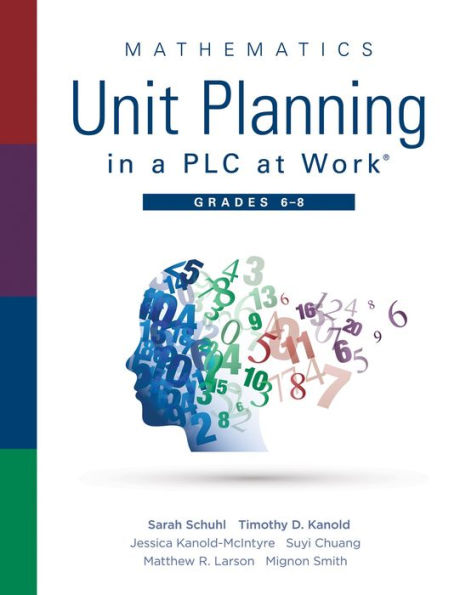What exactly do your students need to know by the end of each unit of mathematics study throughout the school year? This practical resource empowers teacher teams to collectively plan for and deliver highly effective units of study in grades 6-8. The authors clearly outline how to generate essential learning standards, create a team unit calendar, identify prior knowledge, and complete many other essential collaborative tasks.
Use this resource to provide intermediate grade-level students with a more equitable mathematics learning experience
- Understand how to collaboratively plan mathematics units in grades 6-8 as a professional learning community (PLC).
- Study the seven unit-planning elements and learn how to incorporate each in essential unit design.
- Review the role of the PLC at Work® process in enhancing student learning and teacher collaboration.
- Observe three model units, one for each grade, for ratios and proportional reasoning.
- Receive tools and templates for effective unit planning.
Contents:
Acknowledgments
Table of Contents
About the Authors
Introduction
Part One: Mathematics Unit Planning and Design Elements
Chapter 1: Planning for Student Learning of Mathematics in Grades 6–8
Chapter 2: Unit Planning as a Collaborative Mathematics Team
Part Two: Proportional Reasoning Unit Examples, Grades 6-8
Chapter 3: Grade 6 Unit--Ratios and Rates
Chapter 4: Grade 7 Unit--Proportional Reasoning
Chapter 5: Grade 8 Unit--Linear Functions and Equations
Epilogue: Mathematics Team Organization
Appendix A: Create a Proficiency Map
Appendix B: Team Checklist and Questions for Mathematics Unit Planning
References and Resources
Index
What exactly do your students need to know by the end of each unit of mathematics study throughout the school year? This practical resource empowers teacher teams to collectively plan for and deliver highly effective units of study in grades 6-8. The authors clearly outline how to generate essential learning standards, create a team unit calendar, identify prior knowledge, and complete many other essential collaborative tasks.
Use this resource to provide intermediate grade-level students with a more equitable mathematics learning experience
- Understand how to collaboratively plan mathematics units in grades 6-8 as a professional learning community (PLC).
- Study the seven unit-planning elements and learn how to incorporate each in essential unit design.
- Review the role of the PLC at Work® process in enhancing student learning and teacher collaboration.
- Observe three model units, one for each grade, for ratios and proportional reasoning.
- Receive tools and templates for effective unit planning.
Contents:
Acknowledgments
Table of Contents
About the Authors
Introduction
Part One: Mathematics Unit Planning and Design Elements
Chapter 1: Planning for Student Learning of Mathematics in Grades 6–8
Chapter 2: Unit Planning as a Collaborative Mathematics Team
Part Two: Proportional Reasoning Unit Examples, Grades 6-8
Chapter 3: Grade 6 Unit--Ratios and Rates
Chapter 4: Grade 7 Unit--Proportional Reasoning
Chapter 5: Grade 8 Unit--Linear Functions and Equations
Epilogue: Mathematics Team Organization
Appendix A: Create a Proficiency Map
Appendix B: Team Checklist and Questions for Mathematics Unit Planning
References and Resources
Index

Mathematics Unit Planning in a PLC at Work®, Grades 6 - 8: (A professional learning community guide to increasing student mathematics achievement in intermediate school)
136
Mathematics Unit Planning in a PLC at Work®, Grades 6 - 8: (A professional learning community guide to increasing student mathematics achievement in intermediate school)
136Related collections and offers

Product Details
| ISBN-13: | 9781951075286 |
|---|---|
| Publisher: | Solution Tree Press |
| Publication date: | 07/31/2020 |
| Sold by: | Barnes & Noble |
| Format: | eBook |
| Pages: | 136 |
| File size: | 8 MB |
